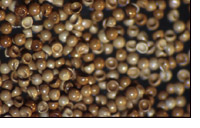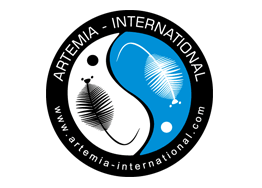TECHNICAL INFORMATION ARTEMIA CYSTS
ARTEMIA CYSTS ANALYSIS Great Salt Lake (GSL) Strain (Artemia Franciscan)
1) Proximate Analysis
| Protein | 50.0% minimum |
| Fat | 19.0% minimum |
| Fiber | 2.0% maximum |
| Ash | 6.1% minimum |
| Moisture | 8.0% maximum |
2) Fatty Acid Profile
|
|
Stearicc |
|
|
|
Oleic |
|
|
|
Linoleic |
|
|
|
Octadecatetra |
|
|
|
Arachidic |
|
|
|
Arachidonic |
|
|
|
Eicosatrienoic |
|
|
|
Eicosapentaenoic (EPA) |
|
|
|
Docosahexaenoic (DHA) |
|
|
|
Omega-3 Fatty Acids |
|
3) Microbiological
Analysis
|
Marine Bacteria (CFU/g.) |
10,000 maximum |
|
Yeasts/Molds (CFU/g.) |
1,000 maximum |
|
Coliforms (MPN/g.) |
10 maximum |
|
E. coli |
Negative |
|
Salmonella |
Negative |
|
V. cholerae |
Negative |
4) Heavy Metals
(microgram/gram)
|
Cadmium |
|
|
Copper |
|
|
Lead |
|
|
Mercury |
|
5) Pesticides (microgram/gram)
|
Chlorinated Hydrocarbons |
|
|
Organo-Phosphates |
|
|
PCB — Total |
|
|
Trichloroethylene |
|
The following were not detected (detection level = 10 ppb):
HCB, BHC, LINDANE, HEPTACHLOR, ALDRIN, HEPTACHLOR EPOXIDE, DDE, DIELDRIN, ENDRIN, DDD, DDT, MIREX, METHOXYCHLOR, CHLORDANE, TOXAPHENE, DIAZINON, METHYL PARATHION, MALATHION, ETHYL PARATHION, ETHION, AND RONNEL.

GREAT SALT LAKE QUALITY CONTROL
 100% Brine Shrimp (Artemia Franciscana) Cysts
Origin: Great Salt Lake, Utah, USA
100% Brine Shrimp (Artemia Franciscana) Cysts
Origin: Great Salt Lake, Utah, USA
Hatching Criteria - Hatching density of two grams of cysts per liter of saltwater, 28 C incubation temperature, strong aeration and constant illumination over 24 hours. Cyst count is approximately 270,000 cysts per gram
|
|
|
|
|
|
|
|
|
Grade A |
85% |
253,000 |
|
|
|
|
|
Grade C |
75% |
235,000 |
|
|
|
|
|
|
|
|
|
Grade D |
60% |
180,000
|
Biometrics
|
|
|
|
|
|
Processing and Packaging - The raw cysts are harvested directly from the Great Salt Lake (Utah), stored at sub-zero temperatures, washed, and dehydrated in modern fluidized bed dryers. The dried cysts are then vacuum-sealed in tin cans (15 or 16 oz.) and packed 12 per case. Storage temperature of finished product is 4 C.
Aquaculture Feed Application - Live feed for larval and post-larval shrimp and fish. Not for human consumption.
Storage - For best results, store under refrigerated conditions between 0 C and +6 C for up to six months. Otherwise, store in a cool place where temperatures will not exceed 28 C for up to 30 days. Keep out of direct sunlight.

ARTEMIA CYSTS HATCHING FAQ

Left to right: Artemia slick, corralling artemia, concentration of artemia, hatch test cones.
What are the guidelines for Artemia cysts?
Salinity - 20 - 30 parts per thousand (ppt) salt solution or approximately 1-2 tablespoons of rock salt per quart (or liter) of water. This equates to around 1.015-1.020 specific gravity. A 20% (or around 1/2 teaspoon per quart) concentration of Epson salt or magnesium sulfate can be added to further buffer the hatching solution.
Temperature - Optimum temperature for a 24 hour complete hatch 26-28° C. Lowering the temperature would result in a longer hatching time. Do not exceed 30°C.
Light - Illumination is necessary to trigger the hatching mechanism within the embryo within the first few hours of incubation. Maintaining a light source during the entire incubation period is recommended to obtain optimum hatch results and for temperature control.
Aeration - Constant aeration is also necessary to provide sufficient oxygen levels for the cysts to metabolize and hatch. A minimum of 3 parts per million dissolved oxygen during the incubation is recommended. Strong aeration will not damage or hurt the brine shrimp cysts or nauplii.
pH - A starting pH of 8.0 or higher is recommended. If pH drops below 7.5 during incubation, add a teaspoon of sodium bicarbonate or a pH buffer to raise it above 8.0.
Stocking Density - 2 grams per quart or approximately one level tablespoon of cysts per quart is recommended. A higher stocking density will result in a lower % hatch.
Hatching Cone - Flat bottom hatching vessels should be avoided. Cone or "V" bottomed containers are best to insure that the cysts remain in suspension during hatching. Be sure to thoroughly wash the hatching cone with soap and water and allow to air dry between uses.
How do I harvest the baby brine shrimp?
To harvest the baby brine shrimp or nauplii, simply shut off the air and wait a few minutes for the shells and nauplii to separate. The shells will float to the surface and the live nauplii will go to the bottom of the cone towards the light source. Once separated, the nauplii can be siphoned from the bottom or drained from the bottom of the cone through the air tubing.

ARTEMIA CYSTS DECAPSULATED FAQ
What is decapsulation?
The hard shell that encysts the dormant Artemia embryo can be completely removed by short term exposure to a strong hypochlorite solution. This procedure is called decapsulation. Decapsulated cysts offer a number of advantages compared to the non-decapsulated cysts.
What are the advantages for using decapsulated Artemia cysts?
For one, cyst shells are not introduced into the culture tanks. When hatching normal cysts, the complete separation of Artemia nauplii from their shells is not always possible. Unhatched cysts and empty shells can cause mortalities in fish fry as pieces of the shell or corion can be lodged in the digestive tract of the fish or shrimp.
Improved hatching percentages, by as much as 10%, can also be expected from using decapsulated cysts. This is due to less energy required for the embryo to " burst" through thin hatching membrane surrounding the embryo.
The decapsulated eggs are also thoroughly disinfected, thereby reducing the bacterial load of the hatching medium during incubation.
Lastly, the unhatched cysts (following incubation) are still edible and easily digestible by your fish. In fact, the energy content found in unhatched Artemia cysts is higher than that of a hatched, live baby Artemia. This is a very valuable course of action when Artemia cyst hatching quality is poor.

DECAPSULATION PROCEDURE
Ingredients:
500 grams Artemia cysts (do not use Russian origin cysts)
4.77 liters sodium hypochlorite (household bleach)
75 grams sodium hydroxide
2.2 liters of water
1) Hydration
Dry cysts resemble deflated basketballs under the microscope. The cysts must be fully hydrated or spherical before decapsulation is to begin. Simply hydrate the cysts in a half-bucket of fresh water with aeration for one hour.
2) Decapsulation
Dissolve sodium hydroxide in 2.2 liters of water and allow to cool. Do not add hypochlorite until ready to decapsulate. Collect the hydrated cysts in a 125 mesh sieve and drain. Add the sodium hypochlorite solution to the sodium hydroxide and water followed by the hydrated cysts.
The cyst color should change from brown - gray - white - orange within a few minutes, depending upon the strength of the chemicals and the thickness of the shell or corion. When the cysts are 90% orange, stop the reaction immediately by pouring the decapsulated cyst solution in a fine mesh bag and rinse well with lots of freshwater.
To assure that the decapsulation reaction is stopped, have a solution of .1 normal hydrochloric acid (HCl) ready to stir the cyst in for one minute. Prepare this solution by adding 65 ml of hydrochloric acid (35% active) into 6.5 liters of water. A weak solution of sodium thiosulfate can also be used to neutralize the chlorine.
Can I store decapulated cysts for later use?
Decapsulated cysts that are not used for hatching right away can be stored for later hatchings. Drain or remove all excess water from the decapsulated cysts. Add brine water (300+ ppt salinity) until the cysts are completely covered. The brine water will pull the water out of the cysts or dehydrate them again. If the cysts are to be stored for several weeks to a month, replace the old brine water with new brine water after 24 hours. Store the decapsulated cysts (in brine water) in the refrigerator for up to one month.
